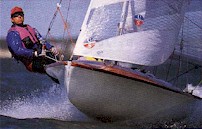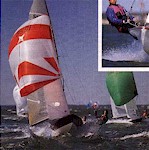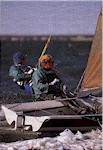|
The
post-Worlds party is always rowdy. On the Hyannis (Massachusetts) Yacht Club patio,
following seven days of world-class high-performance dinghy racing on Nantucket Sound, the
505 fraternity 200 plus sailors (almost all male), each with an implicit vow to reach
his way through life celebrates the class's forty-third world championship in typical
form: fast and fun. The party din smothers the sound of the band; a sailor streaks naked
waving an American flag; and a mischievous group prepares to toss the winners in the
water.
As the first American 505 world champions in 16 years, the
winners, Nick Trotman (Manchester, Massachusetts) and Mike Mills (Newport, Rhode Island),
are busy. Off in a corner, Trotman talks into a Cape Cod reporter's tape recorder. The
reporter asks the question the duo has been working to solve for six years: "How do
you win a world championship?" With a knowing grin, the 27-year-old Trotman responds,
"Speed kills."
Besides speed, 505ers seek fun and serious competition. There's a
lighter-side joke about 505 sailing: "We were having so much fun reaching, when we
got to the mark we just kept on going." There's a competitive side, too.
"Overbearing in victory, surely in defeat," an old regatta T-shirt reads. The
legends Paul Elvstrom's conquests in the 1950s, Swede Krister Bergstrom's four-year run
(1987-89 and 1991) at the Worlds, and, more recently, British dominance, including four of
the last five world champions inspire the top teams to find that extra gear of speed.
Most will agree that jumps in speed can't be found alone.
"You're only as good as your group," says Florida sailmaker Ethan Bixby. For
years the top Brits have capitalized on 60-boat regattas, group tuning, and short travel
for racing. Although the craze for newer high-performance dinghies in England has reduced
the size of their fleet, the core group, including world champions Ian Barker (1993) and
Mark Upton-Brown (1997) and 23 other teams that sailed in Hyannis, is still very active.
Motivated by a home venue and a rising group of college-trained sailors Trotman, Mills,
local Tyler Moore, Bristol Rhode Island's Mike Zani and his three-time North American
champion crew, Peter Alarie American 505 sailors teamed up to (heaven forfend they call
it training) "blast around." The American effort, on the weekends and at
regattas, was raised a notch on both coasts.
|

Race 4 is telling.
Trotman and Upton-Brown, tied in the series, round the first mark twelfth and fourteenth,
respectively. Both setting up high on the reach centerboard height adjusted critically,
mainsail flat and twisted, trapeze crew surfing the rail and working the spinnaker
they
start marching by one boat at a time. At the gybe mark, Trotman is eighth, the Brits
tenth. By the leeward mark, another clump of boats gone, they've both picked up two more
spots, looking to strike the top three. On the third (of four) beat, Trotman in fourth
sails left of the pack, while Upton-Brown heads far right. ("You've got to know how
to work the corners," Hamlin says.) The Yanks lead out of the left corner in a
favorable shift; they'll win the race. The Brits fade on the back side of the shift, and,
with three races to go, only Barker can stop the Americans winning the series.
After the race Mills explains the need for speed on a Worlds
course (14 miles, 9 legs). "It's a very long race, but the clock is ticking. You've
got to pass boats early and often."
|

The
POWERED-UP AND ENDLESSLY tweakable 505 was ahead of its time when it was designed by John
Westell in 1954. It is narrow on the waterline, but its flaring sides give it stability.
The mast/sail combination is powerful, and teams typically have a 200-pound crew on the
wire. (Bill Masterman, a 6 foot, 8 1/2-inch Brit, is the ideal for which every
skipper searches.) However, adjustable rig controls, mast rake, shroud tension, a
deck-mounted mast ram, and movable jib leads allow smaller crews and skipper to depower
and compete against the bigger teams.
And 505 sailors like to tweak. Skippers often take a
little-of-this, little-of-that approach to tuning. With experience, shifting gears is
automatic, but class newcomers are uncertain about tuning the 505. "At times we're
well-tuned, competing in the top ten," says 1996 college sailor of the year Tim
Wadlow. "Suddenly we're off a little and back in the sixties. And once you're
mid-fleet, you have to fight to stay there." In the parking lot, the sailors exchange
their settings of ram, rake and vang, noting, under the class's no-secrets policy, what
worked and didn't.
|
 Barker, a full-time
sailor in England, discovered a racing element he didn't expect to find at the Worlds.
"Americans tune their boats for height. Europeans don't; we foot and sail fast. So in
a fleet that is one-third American, we found we had to change the way we sail upwind just
to keep lanes." By using gate starts, in which each boat starts on starboard tack
ducking the port-tack "pathfinder" boat, the 104-boat fleet starts evenly. So
being able to "hang in the initial drag race," Trotman explains, is critical for
a good finish.
The tweaking doesn't stop off the water. Although the 505 is
strictly one-design, there is room for development in sails, hulls, and foils. Many
players, for example, arrived in Hyannis with lightweight Kevlar mainsails. Ullman
sailmaker Jay Glaser, who has been designing 505 sails for 24 years, worked with Hamlin on
his latest Kevlar sails. Foils are even more open for development; the centerboard rule
specifies only that it must fit in the trunk. Baltimore lawyer and 505 lifer Macy Nelson
worked with Waterat's Larry Tuttle on a radical set of foils. His centerboard and rudder
are both high-aspect shapes, as much as 5 inches deeper than the average blades, designed
to generate more lift. The gains from such experiments are not easy to quantify, but half
the fun is trying.
|
|
Since the
popular hulls Rondar, Waterat, Kyrwood, Lindsay, Parker have similar shapes, 505ers
usually select boats based on material and cost. Most boats are foam-cored with Kevlar,
carbonfiber, or S-glass in the outer and inner skins. Speed differences in the
hulls?" At the end of the day the good guys win with any boat," says Ali Meller,
a computer analyst and class fireplug from Gaithersburg, Maryland. Trotman, sailing a
two-year old Rondar, practiced mainly with Newporter Tim Collins, who won race 2 in a
Kyrwood, and Zani, who sails a 1981 Lindsay, known as the "Dump Truck."
Around the dinghy park, Mark Lindsay-made 505s stand out from the
rest. His Kevlar-skinned performer redefined 505 construction in the late 1970s and
instantly rendered the time's polyester-resin boats obsolete. Lindsay wooden decks are
high maintenance compared to today's glass. And the popular launcher tube has replaced the
spinnaker-bag system. But the bulletproof hulls, which the Brits joke should be on display
in the Greenwich Museum, are still up to speed. "That's why we stopped building
them," says Mark Lindsay. "They don't go away."
As a
class, the 505 has the key elements of a lasting one-design a good used-boat market,
strong leadership, and a cliquish group of sailors. A lot of factors the Internet
(www.sailing.org/int505), Meller's persistent recruiting and marketing, non-Olympic class
status account for the class's strengths and recent growth. But success comes largely
from being a boat that is fun to sail and ever-fascinating for a lot of people. Ask any
505 sailors a 45-year old land broker, an ex-Olympian, a former Whitbread sailor,
76-year old Marcel Buffet, a past collegiate all-American and they'll all agree:
"The boat just feels right."
The 40-something lifers, most with 20 years of 505 tales and high
speed yawps, may not be as fit (or have as much time to train) as the younger guys, but
they're satisfied with a boat that's a blast to sail. "When you're on the water, the
505 seems like the only boat on earth," says former Lindsay boatbuilder, Dave Dyson.
Besides, Tom Kivney adds, "with 31 years of experience, I think I'm getting
better." French legend Buffet's passion for the 505, which has brought him to 38
world championships, is an inspiration to all sailors.
Skippers range in size and are relatively easy to come by; 505
crews are the class stars. (Under class rules, skipper and crew trophies, are the same
size.) Several crews, such Martin, Alarie, and Lewis, own boats. And if you're planning to
attend the Worlds, having a good crew is crucial.
Two-time North American champ Macy Nelson lost his crew early in
the summer, a big blow to a well-prepared program. Then Nelson lucked into another good
crew, Finn sailor Geoff Ewenson, just before Hyannis. "Having a good crew makes all
the difference," says Nelson. "I've sailed with Alarie and Mills they just
make things easy." The 43-year-old veteran's regatta trials got worse when he blew
out his back just before the event. During the pre-Worlds, walking was difficult, hiking
impossible. But with the help of steroids, an anti inflammatory, and "a painkiller
cocktail," Nelson was determined to race in the Worlds. "It's been a rough year,
but my week's getting better. I think I'm ready for some heavy air.
It's
Wednesday, Race 5, and the big breeze everyone has anticipated since Sunday has arrived.
Postponement. Like big-wave surfers who travel long distances for epic surf, 505 sailors
pace the dinghy park awaiting their chance in the men-from-boys conditions. Big crews
smile. Small crews are surly. Race officer Dave Penfield, the 1979 world champion, is
pacing, too. He knows the meaning of a heavy-air race at the Worlds. It's a test: Whose
gear will hold up? Who's in shape? Who's the fastest?
Still postponed, the stories begin. "Remember the Worlds in
South Africa, 1979...Remember the 170-odd boats in England's 'race of the year'...In the
beginning, Howard was a surfer..I beat Paul Elvstrom by one point in 1983..Remember
getting arrested at our first 505 regatta." The stories, recycled from last year's
Worlds, get taller as the week goes on.
Postponement ends as the winds drop to a less-than-25 knot
average. At the gate start, the players are scattered throughout the fleet, ready to duck
and burst into clear air. Trotman and Mills climb to windward in their mid-fleet lane;
Barker, a few boats down, pokes ahead with the Yanks. At the windward mark, they're both
clear ahead of the fleet. Wtih 12 miles to go, it's a two-boat race. Trotman's lead
expands, then Barker takes advantage of their too-loose cover and sneaks by. Another win
for the Americans would have all but sealed the deal, but the Brits won't go easy.
Who's the fastest? Well, the Brits, first and third at the finish
of race 5, still rule in heavy air. But the Americans ("super-Yanks," according
to Masterman) have arrived. Trotman and Mills hold on to win after the 1-1-2 cushion;
Hamlin and Martin rally for second, the 45-year-old skipper's ninth top-five finish at the
Worlds; and Zani and Alarie are fourth, a few points back from Barker.
So what's next? "The thing about the 505," says Nelson,
"is there's always another Worlds."
|